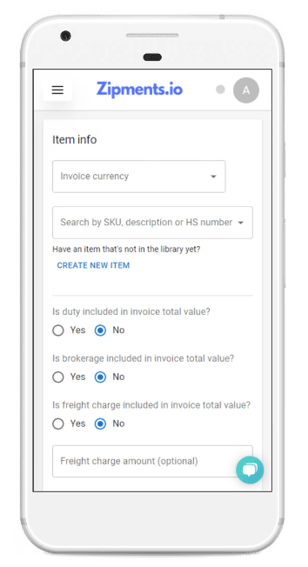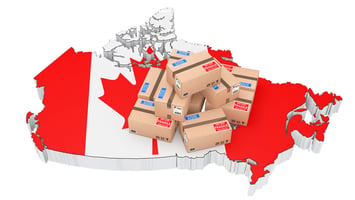Shipping internationally can get expensive. Even though Canada and the United States share a...
How To Reduce Customs Clearance Costs When Importing To Canada
Customs clearance fees are a cost of doing business. In the importing world, however, it's not always easy to predict or estimate how much customs clearance costs will be for a shipment. You should always be aware of the cost of importing. Fees like duties, taxes and brokerage can add up quickly, if you don’t understand how to manage your customs costs. Customs clearance can be expensive, so here's a quick guide on how you can reduce these costs and make sure you don’t get hit with unexpected fees.
.jpg?width=1920&height=1080&name=Blue%20Illustrated%20Dots%20Hosting%20Provider%20Presentation%20(9).jpg)
Canadian Customs Fees
Importing into Canada requires planning and time, because regulations come into play. Even if you are shipping from the US, which shares a border with Canada, there will still be added costs. If you want a smooth importation process, then it is important to know how to save money, time and stress. There are a variety of different fees you may need to pay in order to import goods into Canada. Some of them are unavoidable, while others do provide an opportunity to save money by optimizing your shipping process. Some of the fees you may expect for customs clearance include:
Taxes
One fee you cannot avoid when importing into Canada will be the tax, as this charge is applied to most products entering the country. You may expect to pay GST (Goods and Services Tax), which is at 5% of the product’s value, for Canada. Gifts valued under $60, and items valued under $20 CAD do not require the GST payments. However, since most imported commercial goods will far exceed this value, you should consider budgeting for the GST payment ahead of time.
It is important to keep in mind that some provinces do impose a Provincial Sales Tax (PST) which you will need to account for. The provinces currently implementing PST are
- Quebec
- Manitoba
- Saskatchewan
- British Columbia
Other provinces such as Nova Scotia, PEI, Newfoundland and Labrador, Ontario and New Brunswick do also apply an HST (Harmonized Sales Tax), which is a combination of GST and PST, so that the two payments are not separate, rather they are combined into one fee.
If you are importing to Canada, you can get an accurate estimate of your duties and taxes using the Zipments Duties and Taxes Calculator. The calculator supports excise tax as well, so you can estimate your import costs early.
Brokerage Fees
Most imports into Canada will require the assistance of a customs broker, as it allows for a smoother customs clearance process. Brokerage fees would be included in your total budget, as the tax, duties, and paperwork all cost money. There will usually be a fee paid to the broker for their work in clearing the goods through customs.
Duties
Another mandatory fee you can expect to pay when importing into Canada is a duty charge, which varies based on the type of goods, and their classification. Duties are assessed using a tariff or HS Code, which is unique to each product or commodity shipped and helps identity any free trade agreements which may apply to the product. In order to assess for accurate duty rates, the tariff code has to be correct on your customs invoice.

You can research for the correct tariff, or you can use Zipments easy to complete Customs Invoice Form, which automatically generates the tariff for you, using AI technology. You can ensure the codes is always accurate and avoid overpayment of duties or penalties resulting from entering the wrong tariff on your invoice. With the complete free and easy to use Zipments Customs Invoice Forms, for both Canada and the US, you can;
✅Generate Bill of Lading
✅Send Invoices To Carriers and Brokers
✅Maintain Records For Faster Creation
✅Get Automatic Updates From Broker Sent To You
Ways To Reduce Customs Clearance Costs
Use Preferential Trade Tariffs
You can reduce import costs and enjoy special rates on your imports if you are able to maximize the use of free trade agreements in place. Most countries have multilateral or bilateral agreements with other countries, which means that the duty rate for a specific tariff code changes from country to country. Your shipment will need to have an accurate Certificate of Origin, in order to take advantage of the agreements in place, so it’s important to remember that the country of origin is not always the same place as where goods are shipped from.
Get The Correct Tariff Classification
Reducing customs fees is much easier when you can get the correct tariff or HS code for your shipment, because it helps avoid overpayment or potential penalties such as audits and fines. Using the wrong tariff can result in additional costs you don’t need.
Finding the most suitable or correct tariff for a product can be challenging, as having the wrong code can affect the duty rate and result in higher amount owed than needed. Sometimes duty rates change annually, so keeping up with the tariff classification is important. In order to avoid tariff errors, using Zipments to complete your customs invoice will help you stay in compliance, with accurate AI generated tariffs for your goods.
Use a Reliable Broker
The best way to reduce the cost of importing is to use a broker. They will handle all customs clearance fees, duties and taxes so you only have to pay for the product once. Customs brokers do come with direct and indirect costs, so research is important if you are opting to use a broker.
Since brokerage fees are based on the agreement in place with the customs broker, it is also important to shop around and look for the most efficient broker for your business. Get a clear proposal drawn up which outlines the flat fee for a customs clearance package, and the cost of each item within that package. Look for any hidden fees and additional after-hours fee charges, in order to avoid surprises.
Keep Up With Your Paperwork
The most common cause of delays at customs is incomplete or missing documents. To avoid unnecessary fees or time wasted, which can be costly, make sure that your paperwork is complete correctly and submitted on time. If you frequently have paperwork issues, it can lead to costly audits, and you do not want to pay those unnecessary fees, so stay on top of regulation and requirements. You should also be tracking your PARS or PAPS barcode to check if goods are cleared to cross, before a driver even arrives at the border.
Research Your Goods
Some countries have specific regulations pertaining to goods, so it is important to research whether your goods are regulated, as this can lead to added costs. Regulated products vary from country to country, so keeping up to date with your costs based on where you import, is important.
Give Yourself Extra Time
During busy seasons, as well as winter, it is normal to anticipate delays when it comes to shipments. It is beneficial to send your goods at least a few days early, giving yourself a buffer time period in cause of potential delays due to weather conditions or busy seasons.
Get an Accurate Estimate of Your Duties and Taxes
In addition to insurance and transport costs, it is important to have an estimate of your fees. Often businesses will fail to calculate their total landed cost, which includes any GST or other provincial taxes, which can impact their bottom line. It’s very easy to miss the general amount you may need to pay for duties and taxes in the early stages of your planning, so it is important to understand the different fees you may be paying.
When you use Zipments, you can get an accurate estimate of your duties and taxes amount ahead of time for Canadian imports, so that you can budget accordingly and avoid any unexpected costs.
With Zipments Duties and Taxes Calculator, you can input the details of the item you want to import, including its value, country of origin, and product category, and you'll get an accurate calculation of the tariff and duties owed. The calculator also supports excise tax, so you can calculate your total import fees in one go.
When importing, be sure to carefully plan before you begin. The best way to reduce the cost of importing is to do your research, and use the right customs clearance partner. Customs clearance costs can vary from product to product and country to country, so it's recommended that you consult customs experts, or use a platform like Zipments to navigate the process. Zipments is easy to use, streamlined, offers free customs clearance forms and PARS/PAPS tracking. You can navigate your entire cross-border journey with one click. Visit Zipments.io to begin.







.png?height=200&name=Red%20Blue%20Neon%20Technology%20Video%20(5).png)
.jpg?height=200&name=Food%20Presentation%20(1).jpg)